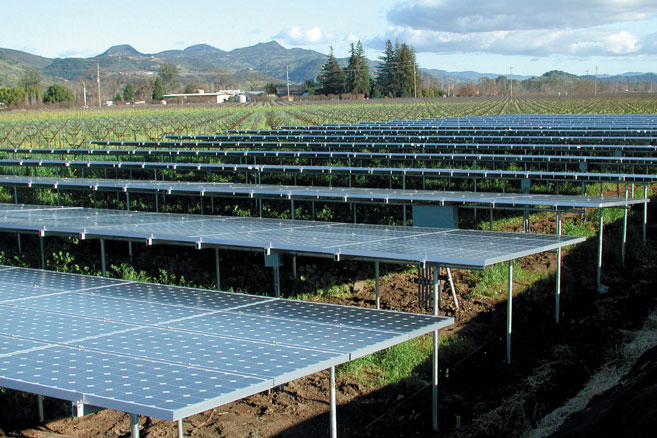Farming The Sun
Local Solar-Powered Food and Drink Businesses Bask in the Glow
As we face the realities and shortcomings of our modern industrial food system, many producers and consumers are drawn towards holistic and sustainable alternatives. Technologies such as pesticides, mono-cropping and heavy machinery once heralded as solutions to feed our growing world have proven detrimental and unsustainable on many levels.
Inherent to these higher-yield methods of production is the increased energy needed by them, often supplied through heavy consumption of fossil fuels. As those precious resources dwindle, not only does the cost of conventional fuel rise, we are seeing a marked shift in the health of our environment.
In response to this growing energy crisis several different sustainable energy sources have arisen, perhaps the most obvious and promising being solar energy. An abundant and renewable resource, humans have been utilizing the power of the sun for centuries, starting first with strategically designed yet simple agriculture and architecture, and slowly evolving to the use of magnifying glasses, mirrors and other simple technologies that amplify the sun’s heat for energy.
Solar power in its modern form began to take shape as early as the 18th century, when a Swiss scientist created the first solar collector designed to cook food. From this seemingly small development the science of solar energy has continued to evolve until today we see radiant heat from the sun harnessed through a variety of technologies that are constantly developing, including solar heating, photovoltaics, solar thermal energy and artificial photosynthesis.
Northern California has long tended towards sustainability and environmentalism. Surrounded by productive agricultural land and protected wildlife areas, solar energy seems like it would be an easy sell to environmentally conscious residents of Marin, Napa and Sonoma counties. But it wasn’t until the early 2000s that solar technology took hold as a viable option for the region’s commercial enterprises. Since that time it has grown exponentially, mirroring a national trend.
According to data provided by Sun First Solar, a San Rafael-based solar energy equipment supplier, the total capacity of solar installations in the U.S. has increased dramatically in the past decade, by nearly 700%. At the same time, the cost of installing solar panels on a typical home has dropped 70% since 1998, making solar much more accessible to the general public. Sun First’s CEO Kim Fink is optimistic about the burgeoning industry and the opportunities it holds for the region’s businesses, including agricultural operations and value-added food and drink producers.
For environmentally conscious business owners, the ethical benefits of solar seem clear. However, business is still driven by economics, and, despite recent cost efficiencies, installing a solar system remains a significant financial investment. The burning question really is if a business can handle going into the red for what many solar companies promise will be major savings later.
Bob Valentino, owner of Stefano’s Solar Powered Pizza in Mill Valley and one of Marin’s earliest adopters, has found solar power to be an invaluable part of his business, even adding “solar powered” to his pizzeria’s name and incorporating the sun into its logo.
“I’ve been doing this over 40 years. Over that period of time I’ve owned 13 or 14 restaurants, and now we have three locations. Installing solar is one of the best investments and business decisions I’ve made.” Although the initial cost of the installation totaled around a quarter of a million dollars, after both federal and PG&E rebates Valentino ended up paying $111,000 out of pocket, less than half the actual cost. And his savings in the years since then have been immense: “We had been paying $1,000 a month for electricity. We put in the solar and the bill dropped to about seven bucks a month. It was really incredible. I’m saving money every month on the electricity bill; over about an eight- or nine-year period I got all of that back. Everything from that point forward is positive cash flow.”
When asked about adding solar panels to the two other Stefano’s locations in Marin, Valentino noted the most common hurdle for urban-based businesses: They just don’t have the space required for the amount of panels it takes to provide a significant amount of energy. Since Valentino owns the building that houses the Mill Valley location, he was able to utilize a large amount of roof space for his system; even then, the panels are not capable of producing enough energy to supply the other businesses in the building. But Valentino has hope:
“I think if the panels were more efficient you wouldn’t need as much space... and we’re moving in that direction, that’s going to happen, obviously. That’s how businesses go: They learn from previous mistakes, they become more efficient. And these panels actually were just replaced about six months ago because they had [developed] more efficient panels.”
Just as we’ve come a long way from the first solar-powered stove to systems that harness enough energy to run a pizzeria, the industry is on a fast-paced upward trend, and future gains in efficiency will only make it more viable for urban business owners to switch over to solar.
One option is to use solar for only part of a business’ energy needs. Alvarado Street Bakery in Petaluma uses solar for just under half of their energy consumption. But with nearly 1,000 panels covering their flat roof, again the issue of space and efficiency comes into play. If next-generation panels produced twice the energy, that same number could provide 100% of the bakery’s extensive energy needs. But even with only partial coverage, Alvarado Street’s marketing director Michael Girkout sees a definite benefit.
“We are a worker cooperatively owned business, so it was a decision made by the owners. The decision to install solar was actually unanimous. It was in line with our philosophy; we’ve always been organic, so this seemed to make sense. The decision was both environmental and economic.”
Even with only 50% coverage, the bakery saw a dramatic reduction in energy costs almost immediately. And with the labor for the installation handled by a solar construction company, the bakery was able to continue business as usual, making the decision to abandon traditional fuel methods that much more agreeable.
While urban businesses face issues of space and availability of flat, sun-facing surfaces, agricultural operations generally have an abundance of both. Many farms, ranches and vineyards are ideal candidates for utilizing solar energy due to the large amount of land they occupy and the likelihood that their property receives sufficient sun to support a productive farm, or they wouldn’t be there at all.
For Bolinas’ Star Route Farms, the oldest continually certified organic grower in California, the issue of coastal fog was top of mind at their initial consultation regarding the installation of solar. With consistently unpredictable weather and a significant number of days that never see sunlight, Star Route’s owner Warren Weber faced concerns that a solar system just wouldn’t be viable.
“When we started we weren’t so sure about that, how we’d get enough sun. But actually we do, we have plenty, so we’re using a credit every month.” The “credit” that Weber refers to is the amount of energy provided to the farm by Pacific Gas & Electric (PG&E) free of charge— an amount directly proportional to the amount of solar energy Star Route’s panels collect and feed into PG&E’s energy grid. As Weber puts it, “The solar energy feeds into PG&E meter and then we get a federal credit, that’s the way it’s done. We’re not off the grid—we’re feeding back into the grid.”
This system creates a more efficient and sustainable system for using solar energy, ensuring that on those especially dark days the farm still receives a consistent power supply.
While the solar power produced at Star Route is sufficient to power only certain administrative, storage and residential buildings on the farm, Frog’s Leap Winery in Rutherford is completely solar powered. Frog’s Leap’s owner John Williams said of the decision to switch to solar 12 years ago, “Grapes already utilize the sun’s energy; it was a no-brainer, really.”
Both Weber and Williams share the same sentiment about solar and agriculture: It’s a natural fit, and part of a holistic approach that is called for in the growing trend of sustainable production. While both are driven by an environmental ethos, they both agree that economic side of the equation must make sense in order to keep solar viable.
“The payback was calculated to be five years; I think it took us seven, but now it’s huge. We store all our case goods cooperatively with other wineries. The biggest cost was refrigeration, so we went solar there at the co-op,” said Williams. He went on to describe a sort of domino effect among other wineries utilizing the co-op, counting up to 23 solar installations inspired by those at Frog’s Leap and the cooperative.
When asked to speculate on the future of solar energy in the wine industry, Williams is distinctly confident in a continued upward trend.
“I don’t think this is real breaking news. People understand the value, it’s often about whether they’ve got an appropriate location. I also think that geothermal energy could be a much greater positive benefit to the wine industry.” The truth of the matter is that solar really just isn’t enough right now, and the needs outstrip the efficiency. Williams sees promise in a combination of geothermal and solar to provide a more comprehensive and sustainable energy source for larger operations such as his own.
“Geothermal is ground-sourced energy, so it means using natural wells. It’s subterranean so at the exit point the liquid is at the temperature of the earth. It’s used as a cooling and heating medium, so when you can use a set temperature, that boosts the efficiency of refrigeration and shows huge reduction in costs.”
While solar has given Frog’s Leap significant returns on investment, Williams sees the interplay between geothermal and solar energy as crucial to the sustainability and efficiency of the vineyard’s energy sources. “Geothermal reduces the amount of solar panels that we need, and since space is valuable in farming, it allows us to use greener methods.”
While the future of solar certainly looks bright, the decision to abandon traditional energy sources is not one that can be taken lightly in today’s still recovering economy. Aside from the requirements of space, sun exposure and architectural amenability, business owners must be ready to invest a significant amount of capital in a system that still takes several years to realize returns. But as Kim Fink of Sun First Solar reports, rebates and government incentives have been improving over the last decade, helping more business owners make the switch.
In an area world-renowned for its agricultural bounty, both edible and potable, as well as for the utilization of organic and sustainable production methods, it only makes sense that local food and drink producers look to natural and renewable energy resources. As we learn to navigate the rapidly developing technologies of our modern world, we are slowly but surely coming around to marrying those industrial, cutting-edge technologies with artisanship and sustainability.
Local weather forecast: sunny days ahead.





